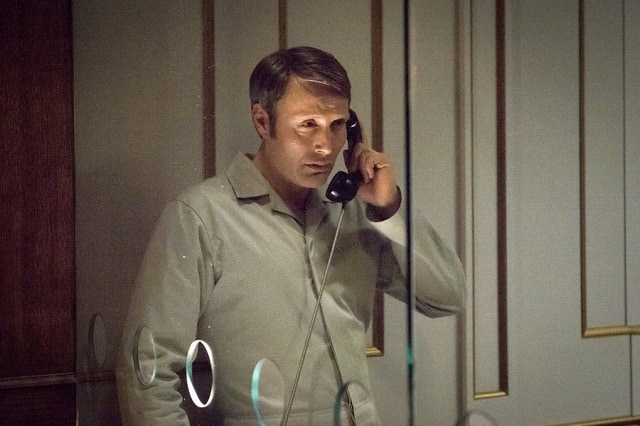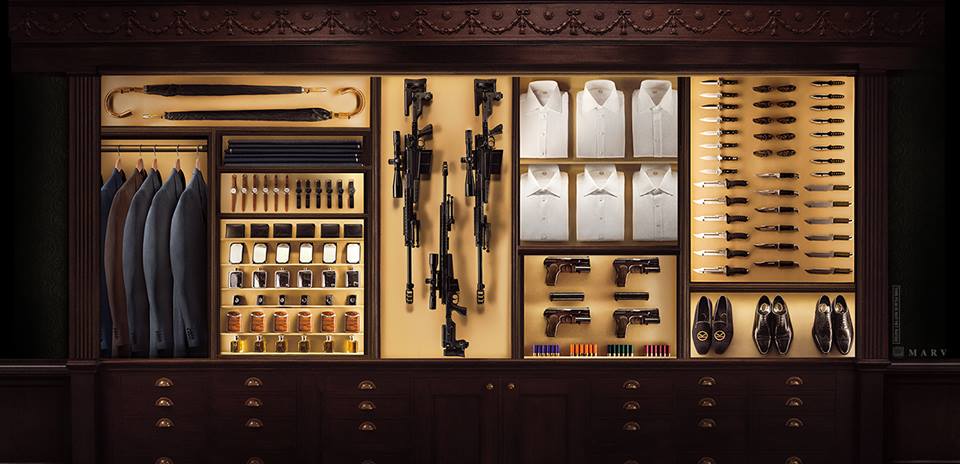Kate’s Classical Corner: Hannibal, Ep. 3.10, “And the Woman Clothed in Sun”
As a classical musician, I can’t help but be influenced in my interpretation of Hannibal by its amazing score and soundtrack, composed and compiled by music supervisor Brian Reitzell. This is not intended to be a definitive reading of Reitzell or showrunner Bryan Fuller’s intentions in regards to the music, but rather an exploration of how these choices affect my appreciation of the given episode. Read my review of “And the Woman Clothed in Sun” here.
Classical piece featured:
Arabesque No. 1, Andantino con moto by Claude Debussy (1891): Reba makes martinis
This gorgeous, early Impressionist piece is a beautiful accompaniment to the continuation of Francis and Reba’s date. It was selected as a specific reference to Harris’ Red Dragon; in the book, Reba remarks on Dolarhyde’s affinity for Debussy’s Deux arabesques and the more romantic Arabesque no. 1 is a much more fitting choice for this scene than the more playful, energetic Arabesque no. 2.
The lush harmonies of this piece, which builds and releases tension throughout, are evocative and warm and both the bass and treble lines stay in near constant motion, arpeggios flowing throughout the main theme of the piece. The intertwining rhythm of the right hand triplets paired with the duple left hand adds motion and complexity, the differing subdivisions of the beat distinct yet working in concert. The solo piano of this piece is a stark contrast to the layered scoring for the Dragon, a far more elegant and unified sound than we’re used to hearing for Dolarhyde. Debussy was inspired by Art Nouveau and its embrace of the curved lines found in nature, clear in the surging melody of this piece. Francis connecting to that, to a focus on shape and line over structure, is telling. He may be a horrific serial killer, but he has great taste in music.
Other scoring notes:
- The scoring of the opening of the episode, as Dolarhyde goes over his speech exercises, features soft but steady percussion with layered instrumentation, including a wash of cymbals and some wind instruments, not all of which feel like they line up metronomically. When Dolarhyde drives to Baltimore and breaks into Hannibal’s former building, however, the elements line up: percussion, piano, electric guitar, etc. This gives the feel of a heist, of the different aspects of Dolarhyde’s plan and preparation coming together so that he can call Hannibal. The steady, quietly driving percussion remains throughout most of the opening, only really falling away when Dolarhyde and Hannibal are talking—then the score features improvisational electric guitar and percussion, along with percussion that sounds to me like the breathing of the Dragon.
- While the percussion builds dramatically to the reveal of the Dragon, the instruments featured are nowhere near as overwhelming as the percussion-heavy score has been at various points in the show’s run. There’s a lot of percussion here, but much of it feels hollow, a wooden rattling of bones rather than the oppressive feel of the early to mid-season two percussion.
- As the camera follows the cables through the wall, the sound becomes distorted and electronic, ending with a drum roll to the reveal of Hannibal’s office and another wash of atmospheric sound as we emerge from the wall.
- The first notes of scoring for the post-credits scene with Bedelia is a dissonant cluster, setting the tone for her scenes this week. I love the effect of the scoring here, which takes advantage of the sing-song delivery from Gillian Anderson to make Bedelia and Will’s dialogue feel like it’s part of the orchestration. This adds to the theatrical, operatic feel of the scene.
 A fun detail: When Dolarhyde asks Reba, about the tiger, “You wanna do it?”, there’s a distinct major seventh in the piano, one of the most dissonant intervals. That’s not ominous at all! It’s immediately followed by perfect fourths on the piano, though, an unresolved, but not foreboding sound.
A fun detail: When Dolarhyde asks Reba, about the tiger, “You wanna do it?”, there’s a distinct major seventh in the piano, one of the most dissonant intervals. That’s not ominous at all! It’s immediately followed by perfect fourths on the piano, though, an unresolved, but not foreboding sound.- The scoring for the tiger scene is lovely, the piano an impressionistic tie to the Debussy that will come with the next scene. The piano line is fluid and inviting (when Dolarhyde says, “I’m right here”, for example, there’s an encouraging flourish), and when supported by the strings that come in, the effect is incredibly lush. That warm sound turns, however, when the strings start to rise as Reba touches the tiger’s ear and reaches down to its mouth. Once Reba’s hand is safely away from the jaws, the strings settle again, and Reitzell allows the audience to enjoy the moment with Reba, and enjoy Francis marveling at her.
- The timing of the next scene’s dialogue lines up well with the Debussy. When Dolarhyde gets uneasy about what their coworkers may have said to Reba, the piece becomes more still, even hesitant and later, when Reba finds Dolarhyde on the couch and sighs, the piece moves to a confident major. This is contributed to with the scoring Reitzell layers over top, a rumble of uncertainty that abates only somewhat when Reba reassures Dolarhyde. Woodwinds come in, and later electric guitar, while the Debussy reprises and then as Reba makes her move, the Debussy is replaced with a steady, repeated perfect fourth in the piano until Dolarhyde sweeps Reba away. This helps transition from the lyrical Debussy to the steady pulse of the still piano-based score for the sex scene.
- As Dolarhyde observes the sleeping Reba, the electric guitar recalls the perfect fourth motif from the start of the tiger scene, but the wash of percussion underneath and other scoring gives it a more minor, mournful feel. Dolarhyde wants Reba to see him, see the Dragon, and not flinch from his teeth, as with the tiger. Their time together can’t last, the score is hinting—it’s already slipping through their fingers.
- When Dolarhyde wakes up alone, we immediately hear the scoring that introduced Dolarhyde in “The Great Red Dragon”. We hear the rattle of teeth and the groan of the Dragon—Reba isn’t safe in the house and Dolarhyde gets her out of there before the Dragon emerges.
- As soon as Hannibal takes his phone call and unscrews the receiver, a drum roll comes in prominently. It could be a nod to the drum roll at the beginning of the episode when Dolarhyde arranged to call Hannibal, but I like to think of it as Hannibal the Magician, performing a feat for an excited crowd: “For my first trick, I will call the outside world. Ta-da!”
- Once it becomes clear that Chilton’s secretary will give Hannibal the information he wants, the strings slide down resignedly, settling on a G for Graham, Will.
- The score for the Will, Bedelia, and Neal scene is comparatively spare; the notes are chosen deliberately, much like Bedelia’s words. The same is true of the scoring for Hannibal and Will’s conversation afterwards.
- The high vocal pitch at the beginning of the final sequence, when Dolarhyde goes through the metal detector, has been used in the score previously, but I can’t place when. If you know, please leave a comment below!
- The scene of Dolarhyde eating the painting has plenty of percussion, but not the same layered elements as the Dragon scoring earlier, when Dolarhyde woke up and Reba was gone. There’s a high wind chime-like sound, some rattling, and drums and cymbals, but not the different, distinct rhythms syncing up with each other, and the strings only come in towards the end, when Will and Dolarhyde see each other. The percussion builds in intensity and speed until it cuts off with Will’s discovery of Dolarhyde, leaving behind soft vocals and the aforementioned strings, and this is when we hear the more characteristic Dragon percussion. The ticking, frenetic drums kick back in as the doors close and Will chases after Dolarhyde, but he’s already gone. It will be interesting to see if this distinction between the Dragon/internal conflict scoring and the Will and Dolarhyde scoring continues moving forward, or if they begin to merge. Either way, I appreciate the ways Reitzell continues to distinguish between the various percussive sound worlds he’s created for different corners of the show.
For even more Hannibal talk, check out the weekly podcast I cohost with Sean Colletti, This Is Our Design. This week, to discuss “And the Woman Clothed in Sun”, we’re joined by one of the episode’s writers, Don Mancini!







